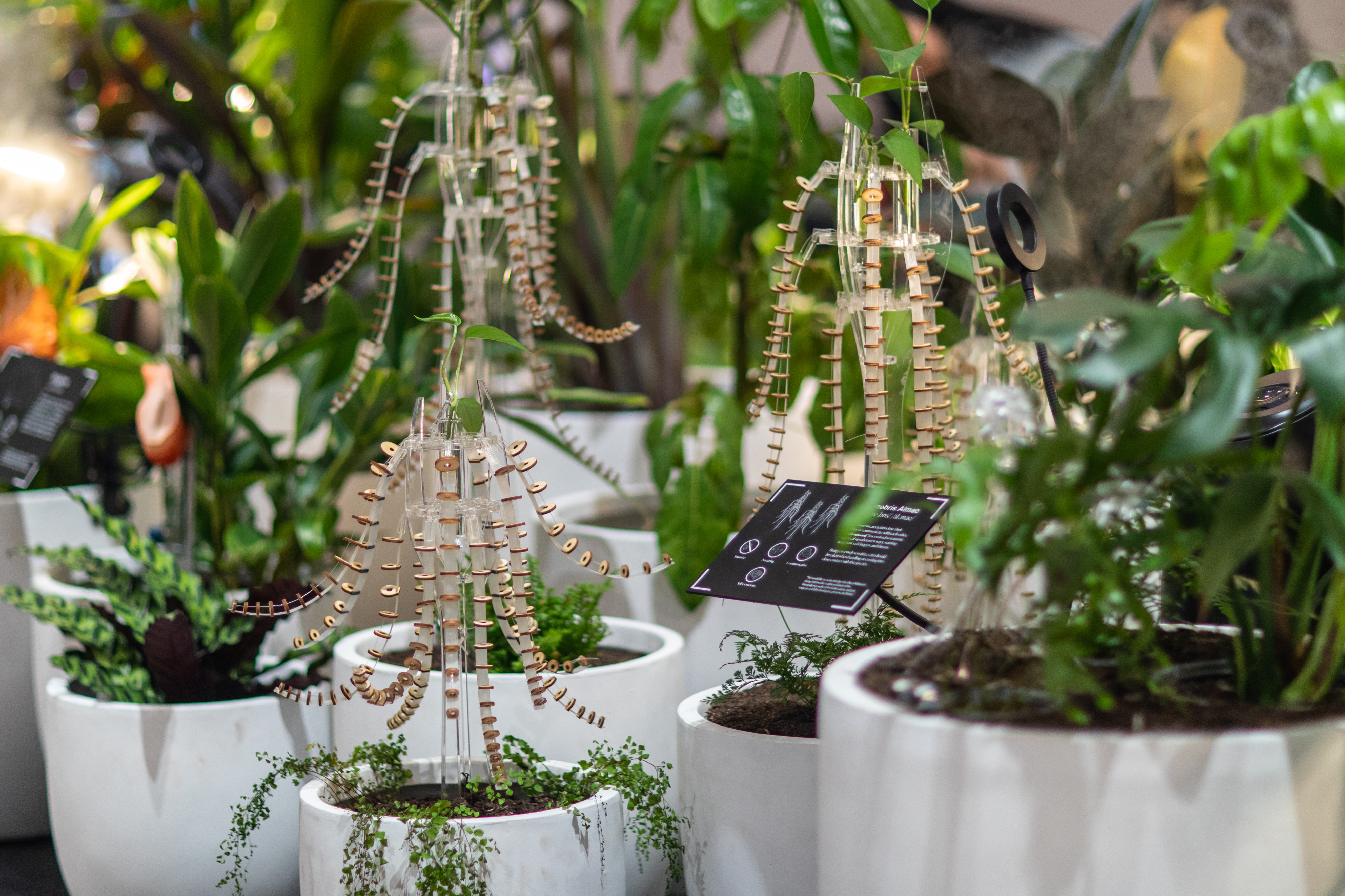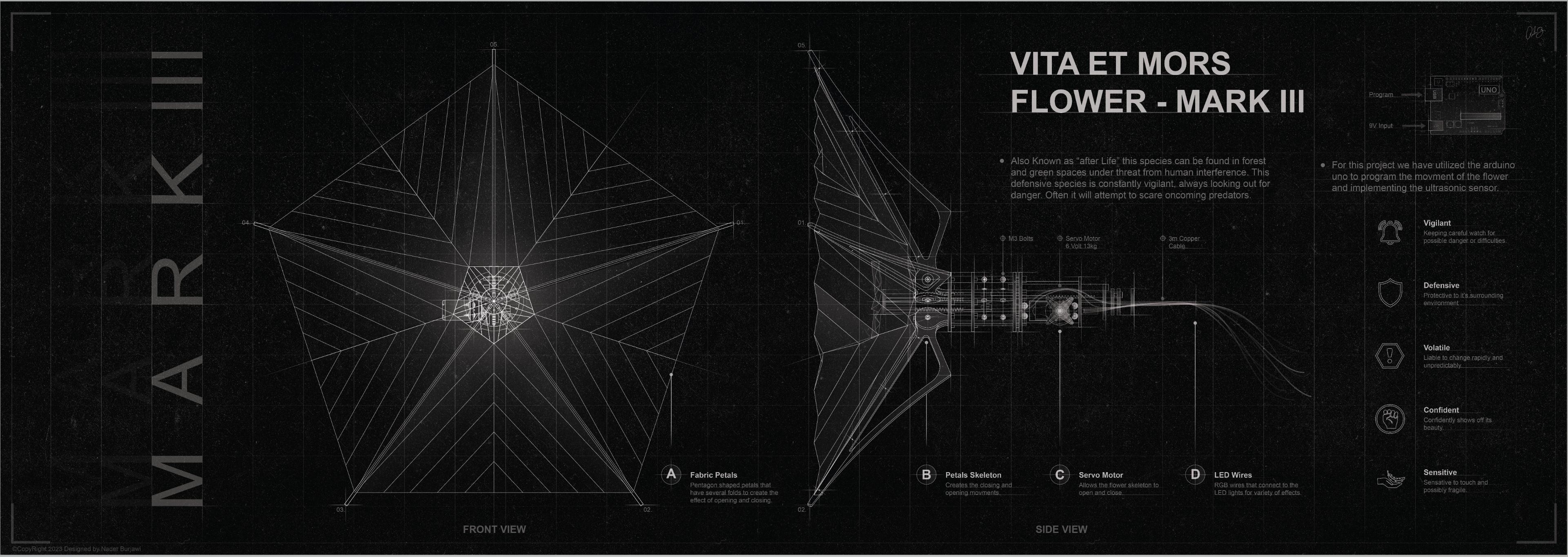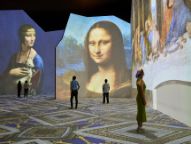Swinburne students craft garden of the future

In summary
- Swinburne students have designed and built a collection of weird and wonderful bionic plants as part of an interactive installation called Future Gardens.
- The installation was facilitated by a partnership between Swinburne and multi-disciplinary design studio UnitedMake, who provided students with industry insights and the opportunity to publicly exhibit their work.
- Students developed technical skills, creative thinking, and design experience while creating their unique specimens.
Science fiction, interactive structures, and biomimicry inspired students crafting the Future Garden exhibition.
Their final creation was an installation for the East Wing Lobby of 530 Collins Street and featured an array of unique hybrid bionic plants that responded to human interaction.

Students shot and edited their own craft video with help from the professionals from UnitedMake.
Nature as inspiration
The project focused on biomimicry, which is the idea of using nature to inspire and inform design.
Students engineered bionic components that were inspired by natural forms, and then integrated these into natural plant life.
They used programming to connect the bionic elements to ultrasonic sensors that measured distance and movement, making the plants react when someone approached.
Architecture student, Nader Burjawi, and his team focused specifically on the movements of flowers.
They researched how irises and chrysanthemums bloom and experimented with how to translate their findings into mechanical movement.
“This project was different from traditional architecture—we got to have a bit of fun,” Nader said.
“We played around with how to create emotions through mechanical movements.”
Their outcome focused on creating a day flower and a night flower.
“The day flower uses wires and mechanical key that would twist give that illusion of blooming and closing,” Nader said.
“The night flower uses a rack and pinion that create different leaves, like a skeleton of the flower, that would open and close.”
Architectural engineering lecturer, Daniel Prohasky, assisted students with mechatronics for the project.
"It was awesome to see the students engage with and understand natural systems,” Daniel said.
“This novel applied method of designing kinetic, artificial systems that mimic nature gave the students confidence in developing complex systems for architecture, towards sustainable solutions for our future buildings."

’Vita Et Mors,’ or the ‘After Life Flower’ is designed to respond to movement and scare potential “predators” .
Unique industry learning
Industry integration was a key part of the project. Swinburne and Melbourne design studio, UnitedMake, collaborated on crafting a challenging but rewarding design brief for students to fulfil.
Mond Qu, UnitedMake Director, worked directly with students to share the studio’s philosophy.
"At UnitedMake, we firmly believe in the principle of designing by making,” Mond said.
“We hold the belief that the iterative process of creating an object, service, or product leads to a better outcome.
“The students' adopted this philosophy, and we hope that they carry it forward in their future careers."
“Mond guided us and made us rethink how to tell stories with our work,” Nader said.
“Even though working on something like a flower is different from our usual architecture work, it shows you that if you have a strong story, it doesn't matter what the project is.”
“I became more focused on storytelling in my other work after that.”
-
 The final exhibition incorporated light, sound, and mist to create a rich atmosphere for the hybrid creations
The final exhibition incorporated light, sound, and mist to create a rich atmosphere for the hybrid creations -
 The final exhibition incorporated light, sound, and mist to create a rich atmosphere for the hybrid creations
The final exhibition incorporated light, sound, and mist to create a rich atmosphere for the hybrid creations -
 The final exhibition incorporated light, sound, and mist to create a rich atmosphere for the hybrid creations
The final exhibition incorporated light, sound, and mist to create a rich atmosphere for the hybrid creations -
 The final exhibition incorporated light, sound, and mist to create a rich atmosphere for the hybrid creations
The final exhibition incorporated light, sound, and mist to create a rich atmosphere for the hybrid creations -
 The final exhibition incorporated light, sound, and mist to create a rich atmosphere for the hybrid creations
The final exhibition incorporated light, sound, and mist to create a rich atmosphere for the hybrid creations -
 The final exhibition incorporated light, sound, and mist to create a rich atmosphere for the hybrid creations
The final exhibition incorporated light, sound, and mist to create a rich atmosphere for the hybrid creations -
 The final exhibition incorporated light, sound, and mist to create a rich atmosphere for the hybrid creations
The final exhibition incorporated light, sound, and mist to create a rich atmosphere for the hybrid creations -
 The final exhibition incorporated light, sound, and mist to create a rich atmosphere for the hybrid creations
The final exhibition incorporated light, sound, and mist to create a rich atmosphere for the hybrid creations
A creative approach to skill development
The Future Garden brief was an exciting and unique challenge for students.
“In the unit, we look at how we communicate with objects and buildings as architects,” Dr Rusenova said.
“The good thing about the project was that students did a lot of hands-on work producing these beautiful objects and at the same time thinking about how these objects talk to us.”
The crafting process taught students technical skills, like programming and how to use sensors, and helped build their creative sensibility.
“We learnt digital software skills and coding, even technical things like efficient ways to laser cut,” Nader said.
"It was encouraging to witness the students' enthusiasm for putting into practice the knowledge they gained in the classroom,” Mond said.
“The exhibition provided a platform for them to showcase their hard work and talents to their families, friends, and the wider community, bringing their learning to life."
-
Media Enquiries
Related articles
-

- Design
Swinburne alum launches zine celebrating Asian Australian art and identity
Swinburne Graphic Design alum Dan Truong founded HOISZN, a zine publication showcasing Asian Australian artists and their work.
Monday 01 July 2024 -

- Design
Swinburne students shine in lighting design collaboration
Swinburne students collaborated with About Space Lighting, resulting in several student-designed lamps being put into production.
Friday 07 June 2024 -

- University
Swinburne University of Technology partners with Grande Experiences and THE LUME Melbourne for cutting-edge Immersive Media education
Swinburne University of Technology is proud to announce its partnership with Grande Experiences and THE LUME Melbourne, enhancing the future of Immersive Media education.
Thursday 13 June 2024 -

- Design
Yarra Trams feature Women in Trades campaign designed by Swinburne students
School of Design and Architecture students in Swinburne’s Bureau collaborated with Tradeswomen Australia Group to design a tram wrap celebrating women in trades.
Thursday 16 May 2024 -

- Design
- Astronomy
- Technology
- University
Swinburne ‘Rock Muncher’ takes part in Australian Rover Challenge
A multidisciplinary student team from Swinburne University of Technology competed in the 2024 Australian Rover Challenge held in Adelaide, South Australia.
Thursday 11 April 2024

